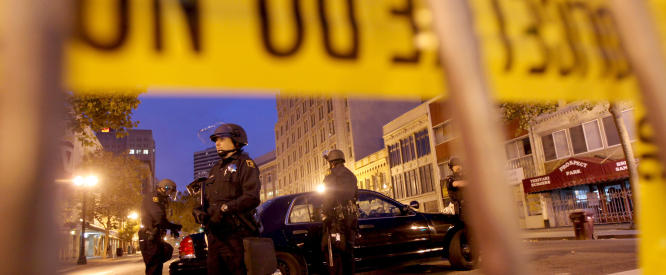
The Oakland Police Department’s Troubled History
Sarah Moughty
The Oakland Police Department has come under fire for tactics used on Tuesday night to clear Occupy Oakland protesters from their camp near City Hall. Police fired tear gas and bean bag rounds, and one protester, Iraq war veteran Scott Olsen, suffered a skull fracture during the melee.
Interim Police Chief Howard Jordan promised an investigation into whether police used excessive force during the clash, but the incident, which has received international attention, is just the latest in a long string of troubles for the Oakland police.
Since 2003, the department has been monitored by a federal judge as a result of a consent decree with the federal government. The decree came following a scandal in which four police officers, who nicknamed themselves “The Riders,” were accused of beating up and robbing suspects and planting evidence while they worked the night shift in a poverty stricken neighborhood in West Oakland.
And earlier this month, U.S. District Court Judge Thelton Henderson threatened to put the department — which is already eight years into what was expected to be a five-year consent decree — into federal receivership. Under the decree, Henderson receives regular progress reports from an independent monitor on the department’s progress on reforms. “We are seriously concerned with the department’s stagnation — and now, reversal — in achieving compliance,” Robert Warshaw, the independent monitor in Oakland, wrote in a report just a few weeks ago.
Among the issues concerning Judge Henderson is how frequently Oakland police officers draw their weapons:
According to a quarterly report, reform monitors took a random sample of police reports of 80 incidents from the first three months of this year and found 215 officers had pointed their firearms. The majority of incidents were justified, the monitors said, but they found that in 28 percent of the cases, officers’ use of firearms was inappropriate and unnecessary. The monitors were also concerned that none of the supervisors reading over the officers’ reports raised questions about the events.
Civil rights attorneys say that the Oakland police department’s actions on Tuesday may violate another agreement the city was forced to sign in 2003, a Crowd Control and Crowd Management Policy that stemmed from a class-action lawsuit filed after police used wooden bullets, sting-ball grenades and bean bag shots to break up an anti-Iraq war protest. At least 58 protesters were injured in that incident.
“They’re supposed to use the minimum amount of force and intimidation. They used the maximum,” attorney Rachel Lederman told The Recorder. Lederman is suing the department for violating the crowd-control policy last year, during protests sparked by the two-year prison sentence handed down to former transit officer Johannes Mehserle, who fatally shot an unarmed passenger. One hundred fifty-two people were arrested in those protests. Lederman says that she may fold Occupy Oakland litigation into her current suit.
Dig Deeper: Investigative Reporting Program at UC Berkeley and Colorlines on how a little-known 2006 California Supreme Court ruling has made it more difficult to uncover cases of police misconduct.
Update (Nov. 2): “As your police officers, we are confused” — Read an open letter from the Oakland Police Officers’ Association to the city’s residents about the “mixed messages” they say they’re receiving from city officials.

Photo: Oakland police block off upper Broadway after breaking up the Occupy Oakland camps in Frank Ogawa Plaza and Snow Park on Tuesday. Oct. 25, 2011 in Oakland, Calif. (AP Photo/Bay Area News Group, Jane Tyska)
Oct. 27, 2011
